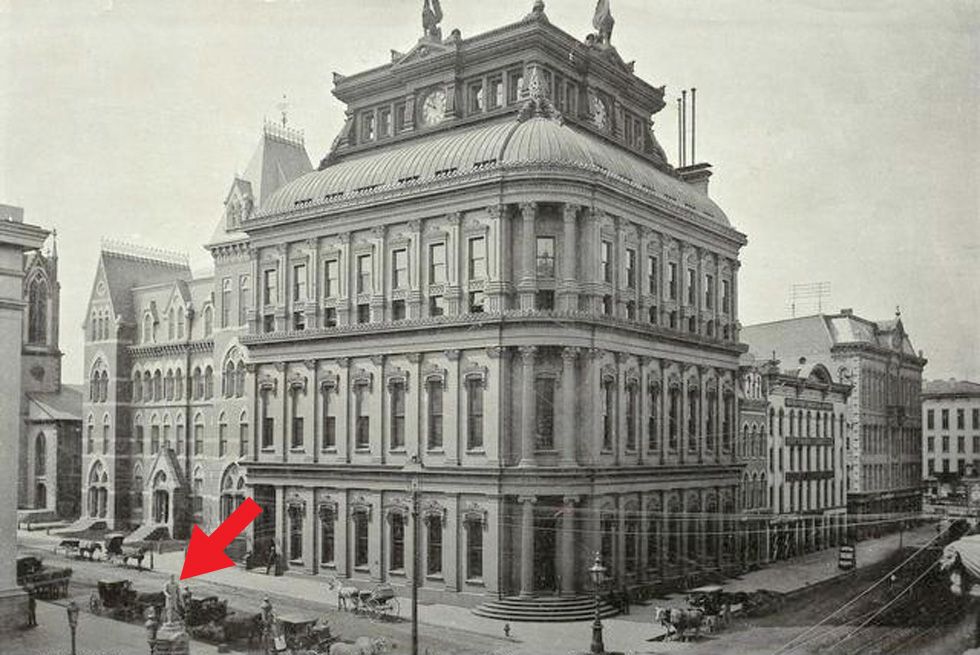This article was scraped from Rochester Subway. This is a blog about Rochester history and urbanism has not been published since 2017. The current owners are now publishing link spam which made me want to preserve this history.. The original article was published September 21, 2012 and can be found here.
![This was the corner of Main and Fitzhugh Streets (1884). Can you find Cogswell? [PHOTO: Rochester Public Library]](https://senseofplace.dev/content/images/photos/rochester-savings-bank-cogswell.jpg)
Often times while I'm doing research for a story, I'll stumble upon something new and get completely sidetracked. Today I was digging for information on the Academy Building when I found the image above. It's a shot of the Rochester Savings Bank building located at the corner of West Main and Fitzhugh. The Academy Building is to the immediate left of the bank. But forget the buildings for now. Do you see that strange little man standing in the lower left corner of the photo? That was actually a drinking fountain named Cogswell...
![One of Dr. Henry D. Cogswell's drinking fountains in San Francisco, (c1888). This looks very similar to the one we had in Rochester. [PHOTO: UC Berkeley, Bancroft Library]](https://senseofplace.dev/content/images/photos/san-francisco-cogswell-fountain.jpg)
According to Wikipiedia, Dr. Henry Daniel Cogswell

(March 3, 1820 - July 8, 1900) was a dentist and a crusader in the temperance movement. Cogswell believed that if people had access to cool drinking water they wouldn't consume alcoholic beverages. It was his dream to construct one drinking fountain for every 100 saloons across the United States; and many were built. In 1883 one was erected in Rochester.
These drinking fountains were elaborate structures designed by Cogswell himself and built of bronze, granite, or sometimes zinc. Like all of his fountains, the one he sent to Rochester was topped with a life-sized statue of a man holding a glass of water in one hand and a copy of the Temperance Pledge in the other. From these photos, Rochester's fountain appears to have been granite and stood about 15 feet high.
Many people thought the statue depicted Cogswell himself and thus resented its presence. However, the figure was supposed to be a symbolic representation of Temperance

. The concept of providing drinking fountains as alternatives to saloons was later implemented by the Women's Christian Temperance Union. And of course in 1919 came prohibition .
![A view of the Cogswell Fountain at the corner of Main and Fitzhugh, looking north with the Powers Hotel in the background. [PHOTO: Rochester Public Library]](https://senseofplace.dev/content/images/photos/rochester-main-and-fitzhugh-cogswell-fountain.jpg)
These grandiose statues were not well received by the communities where they were placed. Washington, DC's Temperance Fountain had been called "the city's ugliest statue." They even spurred city councils across the country to set up fine arts commissions to screen such gifts. In New York, the Park Commissioners appointed a committee of sculptors to report on which statues in Central Park were "most flagrantly in violation of good art and common sense." Can you imagine? Public art police!
After just two years, Rochester's Cogswell fountain disappeared in 1885. This New York Times article

from 1894 gives a brief recount of how our fountain was taken down by bandits in the night! Am I reading that correctly? And, after being taken down by bandits, the City ordered the fountain be disposed of.
![Rochester's Cogswell fountain disappeared in 1885. The NY Times says it was bandits. I wonder if this keystone cop saw anything. [PHOTO: Rochester Public Library]](https://senseofplace.dev/content/images/photos/rochester-main-and-fitzhugh-cop.jpg)
I'd like to know how a 15 foot tall granite statue/fountain "disappears" from the corner of Main Street. If anyone has any information as to Cogswell's whereabouts, please call me!
Cogswell's fountains can be found today in Washington, DC, Tompkins Square Park New York City, Pawtucket, RI, and Rockville, CT. Other examples were erected and then torn down in Buffalo, Rochester, Boston Common, Fall River, MA, Pacific Grove, CA, San Jose and San Francisco.


